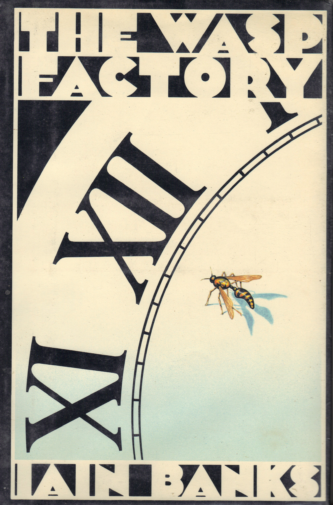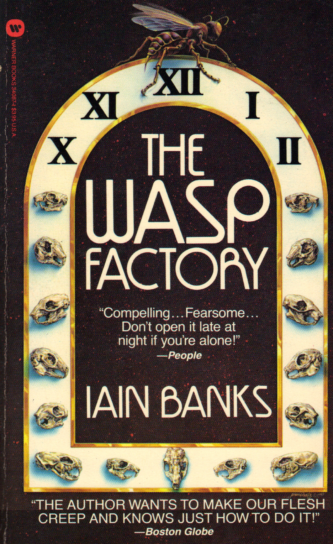 By IAIN BANKS (Macmillan/Warner Books/Abacus; 1984)
By IAIN BANKS (Macmillan/Warner Books/Abacus; 1984)
This is, quite simply put, the finest horror novel of the 1980s, and one of the most accomplished first novels I’ve ever read. Iain Banks’ THE WASP FACTORY is a bold, daring, genuinely shocking and altogether unique piece of work that no one has been able to match—including its own author, none of whose subsequent novels (which include WALKING ON GLASS, THE BRIDGE, CONSIDER PHLEBAS and A SONG OF STONE) can hold a candle to his debut.
It’s the first-person account of sixteen-year-old Frank, a precocious Scottish chap living with his ex-hippie father on a secluded island. Frank spends his days engaged in elaborate war games, utilizing actual explosives he sets off around the island. School isn’t part of Frank’s life, as his father never bothered to officially register his son’s birth. In exchange for keeping quiet about his non-status Frank is allowed to have the run of the island, and his dad even finances his “games.”
How much of what Frank relates about his twisted present and even more twisted past is open to interpretation, as it becomes clear very early on that this kid is a psychopath—albeit the most witty and urbane psycho this side of Humbert Humbert. Frank’s impeccably described outrages include the murders of countless animals—revenge, apparently, for having had his genitals bitten off by a dog years earlier—and three children, one of them Frank’s own younger brother. But Frank is careful to point out that he’s not a killer by nature, as apparently the child murders were “just a stage I was going through.”
Frank’s carefully codified routine is thrown into turmoil when he learns that his older brother Eric has escaped from the insane asylum where he’s been incarcerated for the last several years. Eric it seems lost his mind after seeing a catatonic child’s brain devoured by maggots (a fly having laid eggs under the metal plate strapped to the kid’s head); from there the formerly mind mannered Eric became a babbling hysteric with a penchant for setting dogs on fire and pelting children with worms. Frank is horrified by Eric’s actions, never recognizing that his own activities aren’t that far removed from th ose of his sibling—as Frank laments at one point, “Eric was crazy all right, even if he was my brother. He was lucky to have somebody sane who still liked him.”
ose of his sibling—as Frank laments at one point, “Eric was crazy all right, even if he was my brother. He was lucky to have somebody sane who still liked him.”
Overshadowing it all is the Wasp Factory, the epicenter of Frank’s existence. It consists of a retrofitted clock face with glass over it, into which Frank periodically releases wasps that fall into intricately designed traps corresponding to the twelve numerals, which deposit the wasps in tiny chambers where they meet a variety of horrific deaths (fire, acid, boiling water, etc) that allegedly foreshadow events in Frank’s life. The Factory’s latest prediction involves fire (i.e. the designated wasp enters a chamber in which it’s burned to death), which does indeed turn out to be quite prophetic.
This is a novel of remarkable imagination. It contains passages of profound shock and awe—I haven’t even gone into Frank’s fearsome encounter with a monster rabbit, or the beyond-outrageous twist ending—that are offset somewhat by the cheerful, high-spirited narration. Frank may be a homicidal maniac, but he’s also a complex and fascinating personage who falls somewhere between Tom Sawyer and Norman Bates. His minutely detailed private universe will assuredly leave you shaken, yet the undeniable exhilaration of the novel’s still-unsurpassed imaginative richness registers just as strongly. Obviously THE WASP FACTORY isn’t for everybody, but for the non-squeamish among you it’s an absolutely essential read.
